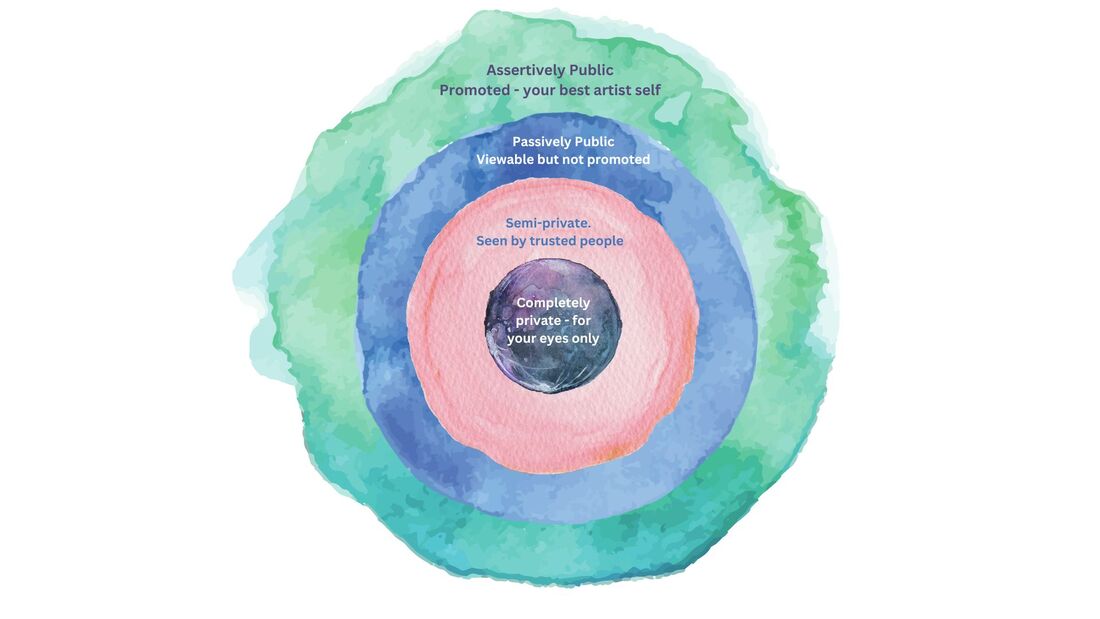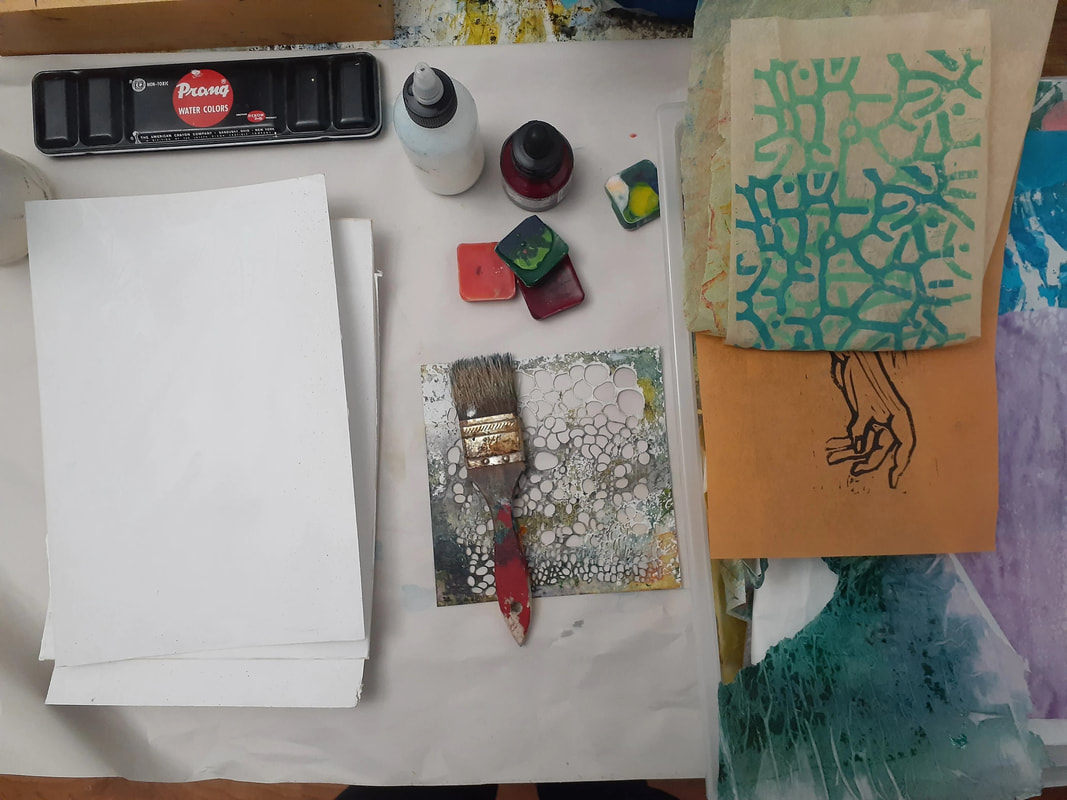|
Last week I talked about the judgmental limiting No, the scared NO. And also the valid NO, the focusing NO.
Why you say yes, why you say no? When do you say yes, when do you say no? What is the timeline of your studio practice, what are the zones of intimacy and privacy in your studio practice? Consider this diagram of the private to public spectrum. The things you create and express are born, live and die on this diagram. They might stay in one circle their entire existence, or they might start in one and move to another. Hopefully outward! How do your Yeses and Nos play out here? We feel obligated to put all of our art out there. Or at least, everything we make should end up in the outer circle, we put that pressure on ourselves. Have you ever made anything that stays in the innermost circle? What needs to happen in order for something born in one circle to move out to another circle? In the very center all is allowed. The glitter, the garish, the naughty, the bad drawing, the experiments, the mess, the unmentionable, the extremely private, the embarrassing. That innermost circle yes is a daring temporary yes, and yes in the moment, a yes to ALL personas ALL the urges. It is cathartic, it is maybe extreme. Many, many artists do not permit themselves this innermost yes. After something is born in the innermost circle, it needs time, YOU need time to see if it is congruent with your other circles. Maybe you will destroy it. Maybe you will hide it. Maybe you will paint over it. Maybe you will protect it and honor it and store it somewhere safe. And maybe it kicks ass and is an honest beautiful raw authentic amazing thing you want to share. How big is your Innermost Artist Voice? Is it hiding in the inner circle, and needs coaxing to come out? Is it being heard? What it has to say changes over time. It speaks in all of the circles over time. Just like we do. But what does it want to whisper? What does it want to say when speaking publicly? Do you have its back? Another aspect to this nesting of circles is the development of individual artworks. This will drastically vary by the artist. Some of us are capable of improvising street art on the side of a building! But for myself, I usually want to start in the inner circle, and the public circle is intruding. So I am often in the semi-private circle. I’ve worked in that inner circle a lot. I still dip into it. I make sure I am not avoiding it. I don’t know, maybe I need to spend more time there. But it's an intense place to be. And not all of us want to make art from there! Maybe you want to paint a still life of some fruit, you know? Anyway, I usually start in the semi-private. I like some privacy, some safety. Also, I need to be bad at it. It needs some time and space to develop, for layers to build, to find a direction. That heavy outline around the inner circle, those are the kind Nos, the chosen limits you’ve given yourself for materials, style, visual vocabulary. These are healthy focused limits, good creative boundaries you use so you can go deeper into your process and imagery. They develop cohesion. The yellow circle is a soft public space. It's your website. Your social media archive. It's been seen, you’ve taken in the response. It has found a home, it is congruent with who you want to be as an artist. The outline around the orange circle is your quality control, and maybe a conditional yes to showing something in progress, sharing your process, behind the scenes, qualifying it with context, that it isn’t done. The outer circle is your sharing it for the first time, declaring it, showing it off, promoting it, offering it for sale. It's what you are most proud of. It is your best artist self. Is there anything you would add to this? Do you travel across the circles? What are the different types of fear and safety you experience in your art? Creativity coaching is designed to support you in navigating these levels. Contact me if you’d like to explore how it can work for you - not a sales call! No pressure, it won’t work if you don’t want it and it would be super awkward ha ha!
0 Comments
Yes is a complete sentence Have you heard the term “No is a complete sentence?” It’s a wonderful concept - you don’t have to explain or justify it when you say no. It's just No. When you start to explain and justify it gives people who are trying to manipulate you or who don’t respect your boundaries an opportunity to break down that no. But it’s just NO. I propose that when it comes to your creative life YES is also a complete sentence. You don’t have to justify or squish your creative impulses. Let yourself play and feel pleasure with the materials you love, the colors you love, the ideas you love, the imagery you love. Can we breathe that in for a moment? Yes. When I get an inspiration, I go through this whole routine of justifying it. Defending it. But I can just say YES if I feel a YES! What thoughts are you having now? Are you having a lot of “buts.” But glitter makes my art look amateur. But so and so said that my colors were garish. But so and so said my painting was boring. My painting was wrong, my painting was dangerous, or safe, or all the things, all the judgments! So we say NO, sometimes to our deepest pleasures! We don’t want to look silly, we don’t want to look like amateurs, we don’t want that feeling of people laughing behind our back or scoffing. We also judge. We judge what we don't want to be. But its all in us. We have in us the toddler being given crayons for the first time. We have the adolescent drawing pretty girls with their hands behind their backs because hands are hard. We have within us the relaxed retiree learning traditional plein air landscape painting. We have the wild abstract expressionist hurling paint. We have the suburban matron with her hobby room full of arts and crafts supplies from Hobby Lobby. We have a designer in love with minimalism. We have the rebel making art with her menstrual blood. We have the hippie painting giant mandalas and goddesses or magnificent tie dye tapestries! We have the beginner who needs to use tools like a projector or AI to achieve their vision. We have the expert who spent years mastering her craft and can’t let go. I could go on. We judge some of them and revere others. We fear being perceived as something we don’t want to be. Our shadow. I don’t want someone to think I’m just ________. So we say no. Not because we wouldn’t enjoy it, but because we don’t want to BE that. We disown that. And when we do that, we also disown everything that persona brings to the table. What does that cost us? You should make your own list, the creative personas you see out in the world, the ones you like and the ones you dislike. Which ones do you revere? Which ones do you disown? What does the disowned persona offer that we might lose when we fight the possibility of BEING that? I’m not saying you have to BE that, I’m just saying that we all usually strongly dislike certain creative paths. There are others we feel neutral about, but the ones that we have strong feelings about, maybe there is some magic in there, or some truth,. You don’t have to become that in order to have the benefits. You just need to stop JUDGING and disowning it, distancing yourself from it. Have some respect for it. You are your own person, it won’t infect you! Is there anything you say NO to that maybe could be a YES? What happens when you try? We have all those personas inside us, but we can't (and shouldn't try) ACTUALIZE them all in real life. We don’t need to. If we are chasing every little thing that interests us, there is a cost to that as well. But give a deeper look to the ones that feel strong. Questions to explore
Your Best Self Must Share Your Studio With Your Inner Depressed Artist. What is the culture of your studio? Is it a place to have discipline and work ethic? Where you compare yourself and your art to what you wish it would be and fret about how you are falling short? A place of inadequacy and laziness?
That might be how it feels when you are depressed. Think of your most fragile, broken, disappointed artistic self. No motivation, feeling down, unable to work, unable to play, messy, dusty and abandoned. That depressed self must also feel comfortable in your studio. That sad hopeless wretch – it is her space too. It should be just as welcoming to her as it is to you when you are bustling with energy and alive with inspiration. Both creatures share this sacred space and if the energy of your studio only welcomes your most successful and driven version, it will not be a safe space for your inner artist when she is not well and needs love and support. When you are at your most motivated, you probably leave a mess. There is no comfortable place to sit because it is covered with sketches or wet paintings needing a space to dry. Brushes left in dirty water, caps left off tubes, excited writing and sketches that might be overwhelming and intimidating to your depressed side. Unfinished work she doesn’t know how to reenter, lacking the confidence to contribute anything of value. Before you leave your studio, assume that you might be in a low mood, low energy, depressed the next day. What does that part of you need to feel welcome? Fresh paper, easy to use supplies laid out in rainbow order, clean brushes ready to go, a bucket ready to be filled with water. Think of it as a closing blessing ritual for the studio to make it a safe welcoming place in case you feel low the next day. And if you are still feeling great the next day? What a delight! This beautifully laid out space, so inviting. |
AuthorLaurel Antur Archives
July 2024
Categories
All
|


 RSS Feed
RSS Feed